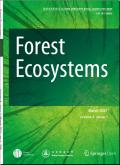Species-specific influences of competition and tree size on drought sensitivity and resistance for three planted conifers in northern China
IF 4.4
1区 农林科学
Q1 FORESTRY
引用次数: 0
Abstract
Droughts have caused tree growth decline and high tree mortality across temperate forests, however, how to manage planted forests to alleviate drought stress is still challenging. We used tree-ring and forest inventory data from different density stands to investigate how competition, tree diameter at breast height (DBH), tree age, and their interactions influence drought sensitivity and resistance for three widely-distributed and planted conifer species (Larix principis-rupprechtii, Picea meyeri, and Pinus sylvestris var. mongolica). Our results showed that the drought sensitivity of the three species was influenced by competition, tree size, and their interactions. Large L. principis-rupprechtii trees were particularly sensitive to drought during the growing season in medium to high-density stands, while the growth of large P. sylvestris var. mongolica was most affected by precipitation at low to medium density stands. Drought resistance of L. principis-rupprechtii trees decreased as tree size increased. Large L. principis-rupprechtii trees had lower drought resistance than small trees in all stands. Drought resistance of large P. meyeri trees exhibited high resistance to drought only in high-density stands. However, drought resistance of P. sylvestris var. mongolica trees was affected by tree size, competition, and their interactions. These results indicated that targeted silvicultural interventions, such as thinning, can be implemented to enhance drought resistance specifically for large L. principis-rupprechtii trees and small P. sylvestris var. mongolica trees in medium and high competition stands, and small P. meyeri trees in high competition stands. Our results highlight that properly conducted thinning can in some cases enhance growth resistance to droughts, depending on stand density, tree size, and tree species.
中国北方三种人工针叶树的竞争和树高对干旱敏感性和抗旱性的影响
干旱导致温带森林树木生长下降,树木死亡率高,然而,如何管理人工林以减轻干旱压力仍然是一个挑战。利用不同密度林分的树木年轮和森林清查数据,研究了竞争、胸径、树龄及其相互作用对三种广泛分布和种植的针叶林树种(落叶松、云杉和蒙古松)干旱敏感性和抗旱性的影响。结果表明,三种树种的干旱敏感性受竞争、树高及其相互作用的影响。在中密度林分,高大的华北杉木生长季对干旱特别敏感,而在中密度林分,高大的蒙古林分受降水影响最大。随着树高的增加,华北冬青的抗旱性降低。各林分中,大乔木的抗旱性均低于小乔木。大型梅氏林分抗旱性仅在高密度林分表现出较高的抗旱性。然而,樟子树的抗旱性受乔木大小、竞争及其相互作用的影响。这些结果表明,针对中、高竞争林分的大榆木和小榆木,以及高竞争林分的小榆木,可以实施间伐等有针对性的造林干预措施来提高其抗旱性。我们的研究结果强调,在某些情况下,适当的间伐可以增强生长对干旱的抵抗力,这取决于林分密度、树木大小和树种。
本文章由计算机程序翻译,如有差异,请以英文原文为准。
求助全文
约1分钟内获得全文
求助全文
来源期刊

Forest Ecosystems
Environmental Science-Nature and Landscape Conservation
CiteScore
7.10
自引率
4.90%
发文量
1115
审稿时长
22 days
期刊介绍:
Forest Ecosystems is an open access, peer-reviewed journal publishing scientific communications from any discipline that can provide interesting contributions about the structure and dynamics of "natural" and "domesticated" forest ecosystems, and their services to people. The journal welcomes innovative science as well as application oriented work that will enhance understanding of woody plant communities. Very specific studies are welcome if they are part of a thematic series that provides some holistic perspective that is of general interest.
 求助内容:
求助内容: 应助结果提醒方式:
应助结果提醒方式:


